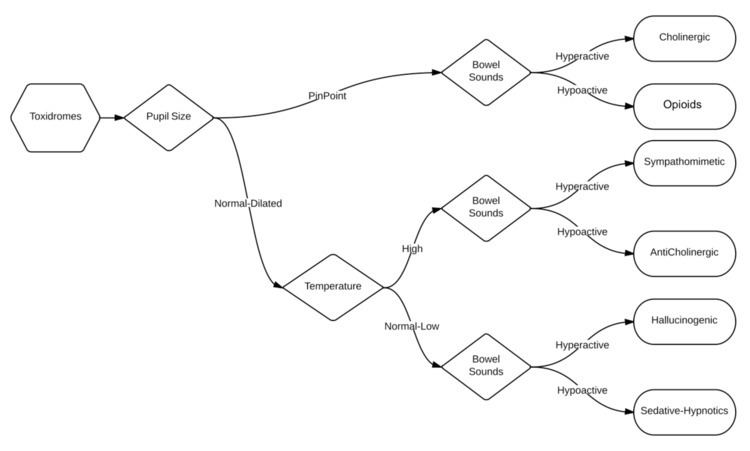 | ||
A toxidrome (a portmanteau of toxic and syndrome) is a syndrome caused by a dangerous level of toxins in the body. The term was coined in 1970 by Mofenson and Greensher. It is often the consequence of a drug overdose. Common symptoms include dizziness, disorientation, nausea, vomiting, and oscillopsia. A toxidrome may indicate a medical emergency requiring treatment at a poison control center. Aside from poisoning, a systemic infection may also lead to a toxidrome. "Classic" toxidromes are presented below, but they are often variable or obscured by the co-ingestion of multiple drugs.
Contents
Anticholinergic
The symptoms of an anticholinergic toxidrome include blurred vision, coma, decreased bowel sounds, delirium, dry skin, fever, flushing, hallucinations, ileus, memory loss, mydriasis (dilated pupils), myoclonus, psychosis, seizures, and urinary retention. Complications include hypertension, hyperthermia, and tachycardia. Substances that may cause this toxidrome include the four "anti"s of antihistamines, antipsychotics, antidepressants, and antiparkinsonian drugs as well as atropine, benztropine, datura, and scopolamine.
Due to the characteristic appearance and behavior of patients with this toxidrome, they are colloquially described as "Blind as a bat, mad as a hatter, red as a beet, hot as Hades (or hot as a hare), dry as a bone, the bowel and bladder lose their tone, and the heart runs alone."
Cholinergic
The symptoms of a cholinergic toxidrome include bronchorrhea, confusion, defecation, diaphoresis, diarrhea, emesis, lacrimation, miosis, muscle fasciculations, salivation, seizures, urination, and weakness. Complications include bradycardia, hypothermia, and tachypnea. Substances that may cause this toxidrome include carbamates, mushrooms, and organophosphates.
Common mnemonics for organophosphate poisoning include the "killer B's" of bradycardia, bronchorrhea and bronchospasm because they are the leading cause of death, and SLUDGE - Salivation, Lacrimation, Urination, Diarrhea, Gastrointestinal distress, and Emesis.
An alternative mnemonic is DUMBBELLSS - Diarrhea, Urination, Miosis, Bradycardia, Bronchospasm, Emesis, Lacrimation, Lethargy, Salivation and Seizures.
Hallucinogenic
The symptoms of a hallucinogenic toxidrome include disorientation, hallucinations, hyperactive bowel sounds, panic, and seizures. Complications include hypertension, tachycardia, and tachypnea. Substances that may cause this toxidrome include substituted amphetamines, cocaine, and phencyclidine.
Opiate
The symptoms of an opiate toxidrome include the classic triad of coma, pinpoint pupils, and respiratory depression as well as altered mental states, shock, pulmonary edema and unresponsiveness. Complications include bradycardia, hypotension, and hypothermia. Substances that may cause this toxidrome are opioids.
Sedative/hypnotic
The symptoms of sedative/hypnotic toxidrome include ataxia, blurred vision, coma, confusion, delirium, deterioration of central nervous system functions, diplopia, dysesthesias, hallucinations, nystagmus, paresthesias, sedation, slurred speech, and stupor. Apnea is a potential complication. Substances that may cause this toxidrome include anticonvulsants, barbiturates, benzodiazepines, gamma-Hydroxybutyric acid, Methaqualone, and ethanol. While most sedative-hypnotics are anticonvulsant, some such as GHB and methaqualone instead lower the seizure threshold, and so can cause paradoxical seizures in overdose.
Sympathomimetic
The symptoms of a sympathomimetic toxidrome include anxiety, delusions, diaphoresis, hyperreflexia, mydriasis, paranoia, piloerection, and seizures. Complications include hypertension, and tachycardia. Substances that may cause this toxidrome include salbutamol, amphetamines, cocaine, ephedrine (Ma Huang), methamphetamine, phenylpropanolamine (PPA's), and pseudoephedrine. It may appear very similar to the anticholinergic toxidrome, but is distinguished by hyperactive bowel sounds and sweating.
